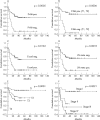Prognostic value of activated Akt expression in oral squamous cell carcinoma
- PMID: 16254112
- PMCID: PMC1770780
- DOI: 10.1136/jcp.2004.024786
Prognostic value of activated Akt expression in oral squamous cell carcinoma
Abstract
Background: Akt is a serine/threonine kinase that plays an important role in tumorigenesis and influences prognosis in several cancers. However, its importance in oral squamous cell carcinomas (OSCC) has not been elucidated.
Aim: To investigate the association between the expression of activated Akt, clinicopathological factors, and E-cadherin, PCNA (proliferating cell nuclear antigen), and VEGF (vascular endothelial growth factor) expression to verify the validity of Akt as a prognostic factor in OSCC.
Methods: Phosphorylated Akt (p-Akt), E-cadherin, PCNA, and VEGF expression were assessed immunohistochemically in 84 OSCCs. The results were analysed in relation to clinicopathological factors.
Results: p-Akt was expressed in 29 cases. It was significantly correlated with lymph node metastasis, TNM stage, and E-cadherin expression. Univariate analysis showed that p-Akt expression, E-cadherin expression, PCNA expression, differentiation, tumour size, lymph node metastasis, TNM stage, and recurrence correlated with prognosis. Multivariate analysis showed that p-Akt expression is an independent prognostic factor in patients with OSCC.
Conclusions: This study revealed that Akt activation is a significant prognostic indicator for OSCC and is correlated with E-cadherin expression. The inhibition of Akt is a possible molecular approach to the treatment of OSCC.
Figures


Similar articles
-
Prognostic significance of CXCR-4 expression in oral squamous cell carcinoma.Oral Surg Oral Med Oral Pathol Oral Radiol Endod. 2009 May;107(5):678-84. doi: 10.1016/j.tripleo.2008.12.047. Epub 2009 Mar 9. Oral Surg Oral Med Oral Pathol Oral Radiol Endod. 2009. PMID: 19272813
-
Expression of vascular endothelial growth factor-C does not predict occult lymph-node metastasis in early oral squamous cell carcinoma.Int J Oral Maxillofac Surg. 2008 Apr;37(4):372-8. doi: 10.1016/j.ijom.2007.11.021. Epub 2008 Mar 4. Int J Oral Maxillofac Surg. 2008. PMID: 18295452
-
Stromelysin 3, Ets-1, and vascular endothelial growth factor expression in oral precancerous and cancerous lesions: correlation with microvessel density, progression, and prognosis.Clin Cancer Res. 2005 Mar 15;11(6):2272-84. doi: 10.1158/1078-0432.CCR-04-0572. Clin Cancer Res. 2005. PMID: 15788677
-
Prognostic factors in oral squamous cell carcinoma. A review of the literature.Anticancer Res. 1999 Jul-Aug;19(4C):3503-10. Anticancer Res. 1999. PMID: 10629643 Review.
-
The prognostic role of clinical, morphological and molecular markers in oral squamous cell tumors.Neoplasma. 2005;52(2):95-102. Neoplasma. 2005. PMID: 15800706 Review.
Cited by
-
Targeting nonhomologous end-joining through epidermal growth factor receptor inhibition: rationale and strategies for radiosensitization.Semin Radiat Oncol. 2010 Oct;20(4):250-7. doi: 10.1016/j.semradonc.2010.05.002. Semin Radiat Oncol. 2010. PMID: 20832017 Free PMC article. Review.
-
Immunohistochemical assessment of growth factor signaling molecules: MAPK, Akt, and STAT3 pathways in oral epithelial precursor lesions and squamous cell carcinoma.Odontology. 2020 Jan;108(1):91-101. doi: 10.1007/s10266-019-00428-4. Epub 2019 May 6. Odontology. 2020. PMID: 31062130
-
Pathologic significance of AKT, mTOR, and GSK3β proteins in oral squamous cell carcinoma-affected patients.Virchows Arch. 2018 Jun;472(6):983-997. doi: 10.1007/s00428-018-2318-0. Epub 2018 Apr 30. Virchows Arch. 2018. PMID: 29713826
-
Cytoplasmic c-ros oncogene 1 receptor tyrosine kinase expression may be associated with the development of human oral squamous cell carcinoma.Oncol Lett. 2015 Aug;10(2):934-940. doi: 10.3892/ol.2015.3340. Epub 2015 Jun 9. Oncol Lett. 2015. PMID: 26622599 Free PMC article.
-
Expression of E-cadherin, Twist, and p53 and their prognostic value in patients with oral squamous cell carcinoma.J Cancer Res Clin Oncol. 2013 Oct;139(10):1735-44. doi: 10.1007/s00432-013-1499-9. Epub 2013 Aug 30. J Cancer Res Clin Oncol. 2013. PMID: 23990016 Free PMC article.
References
-
- Silverman SJ. Oral cancer. 4th ed. Atlanta: American Cancer Society 1998.
-
- Sobin LHWC. TNM classification of malignant tumors. 5th ed. New York: Wiley-Liss UICC, 1997.
-
- Houck JRMJ. Management of cervical lymph nodes in squamous carcinomas of the head and neck. Semin Surg Oncol 1995;11:228–39. - PubMed
-
- Tankere F, Camproux A, Barry B, et al. Prognostic value of lymph node involvement in oral cancers: a study of 137 cases. Laryngoscope 2000;110:2061–5. - PubMed
-
- Piattelli A, Rubini C, Fioroni M, et al. Prevalence of p53, bcl-2, and Ki-67 immunoreactivity and of apoptosis in normal oral epithelium and in premalignant and malignant lesions of the oral cavity. J Oral Maxillofac Surg 2002;60:532–40. - PubMed
Publication types
MeSH terms
Substances
LinkOut - more resources
Full Text Sources
Medical
Miscellaneous
